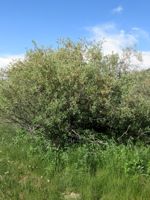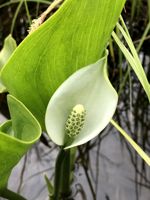Mon-Fri 9am - 5pm Mountain time
Diamond-Leaf Willow vs Water Arum
Salix planifolia
Calla palustris
CUSTOM GROW
CUSTOM GROW
Diamond-Leaf Willow is a native deciduous shrub known for its glossy diamond-shaped leaves, which give the shrub its name. Its catkins emerge in spring, providing an important early source of pollen for pollinators. The shrub’s dense growth also offers valuable cover and browse for wildlife, including moose and deer.
This shrub is well-suited to cool, moist habitats such as wetlands, streambanks, and forest openings. It spreads by rhizomes, helping to stabilize soils and form dense thickets. Diamond-Leaf Willow is valuable for reclamation, wetland enhancement, shelterbelt plantings, and a wide range of conservation and habitat restoration projects.
Water Arum is a native perennial wetland plant known for its showy white oval sheaths (spathe) that surround a yellow-green, cylindrical flower spike (spadix). It has large, oblong, heart-shaped leaves on stems that rise above the water from shallow, spreading rhizomes. The blossoms are followed in late summer by tiny, pear-shaped fruits that ripen to bright red, adding ornamental interest to wet habitats.
Water Arum provides food for birds and small mammals that eat its berries, and its flowers attract pollinators. It can tolerate cold climates and forms colonies in shallow water and saturated soils. It is well-suited for ecological restoration, riparian planting, naturalisation, and habitat projects in wet and shaded environments.
Diamond-Leaf Willow Quick Facts
Water Arum Quick Facts
Toxicity: toxic if ingested

